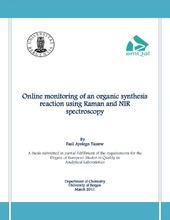| dc.description.abstract | The synthesis of 10-Bromo-1-Decandiol was monitored using Raman and near infrared spectroscopy. Optical fiber Raman and near infrared probes were immersed in the reaction mixture. Raman spectra were recorded every 50 second whereas near infrared spectra were recorded every 30 second. The reaction was carried out for 150 minutes. Data obtained from the spectroscopic techniques went through statistical pretreatment methods. The pretreated data then subjected to multivariate data analysis techniques. Principal component analysis, multivariate curve resolution and partial least square regression were used to identify major trends in the reaction, to identify and monitor the concentration and spectral profiles of the components involved in the reaction and to develop a regression model for the reaction respectively. For the purpose comparison and model development, GC-MS analysis of the reaction mixture was done in 15 minutes interval during the course of the reaction. Principal component analysis on Raman and near infrared data indicated that there were three main components in each data one component in decreasing trend and the other two in increasing trend. This was also confirmed by the GC-MS analysis as there were only three components in the reaction mixture. The decreasing component was assigned to 1,10-decanediol(reactant) while the other two components are assigned to 10-Bromo-1- Decandiol (Product) and 1,10- dibromodecane(byproduct).From concentration profiles obtained from multivariate curve resolution it was also shown that the three components in the reaction mixture followed the same trend as suggested by the principal component analysis and GC-MS analysis. Partial least square regression model was built for both Raman and near infrared data using ten variables from the GC-MS analysis and ten variables from Raman and near infrared. A good prediction was obtained for both data when the model was tested under a different set of variables. As a result, it was concluded that monitoring the synthesis of 10-Bromo-1- Decandiol using Raman and near infrared spectroscopy proved to be feasible. | en_US |
